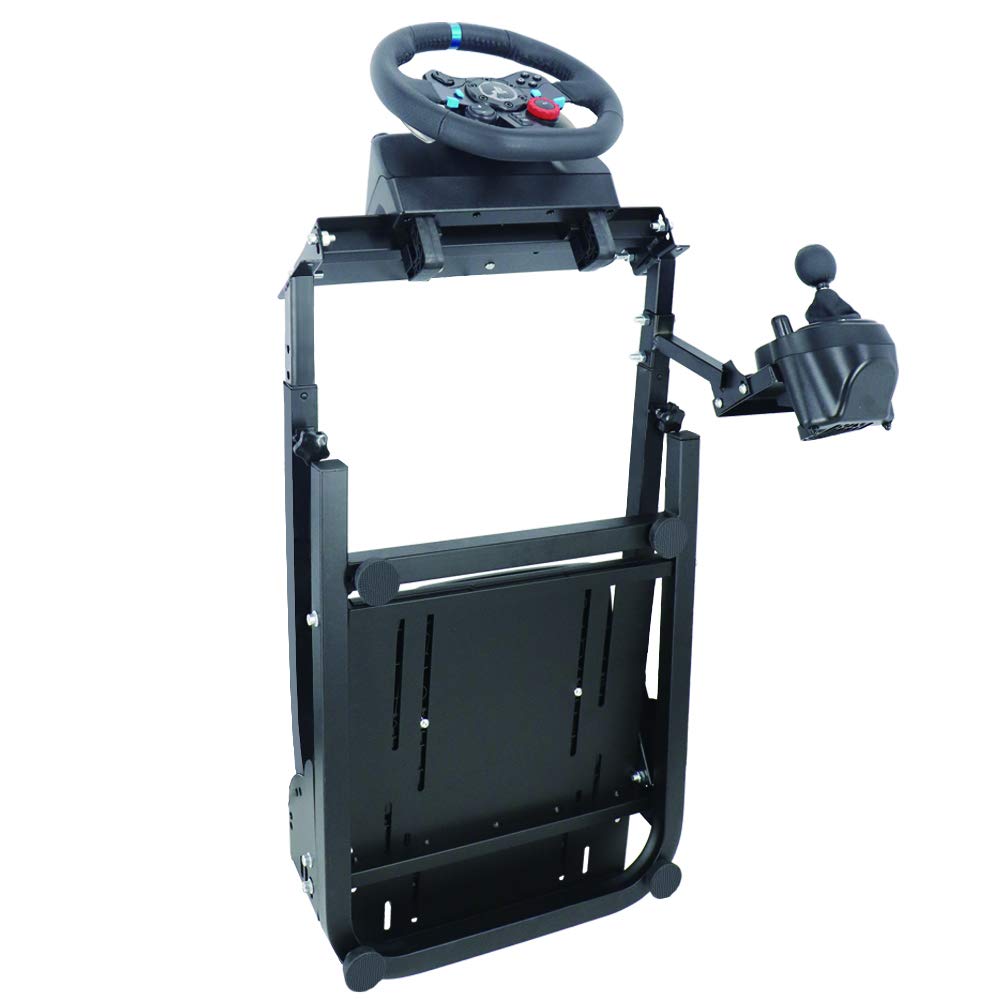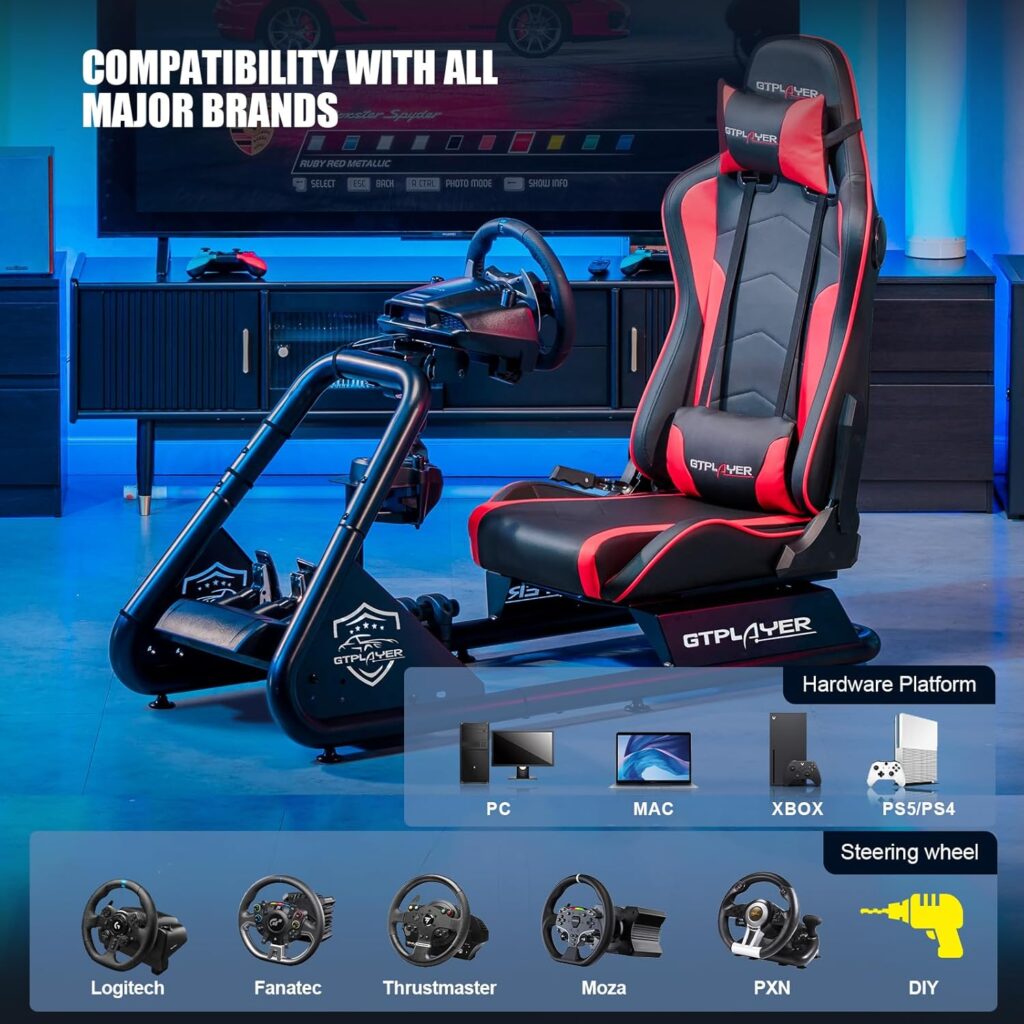Are you a sim racer looking to take your gaming skills to the next level? While virtual racing may not require the physical exertion of traditional racing, there is still a strong connection between physical fitness and performance on the virtual track.
In fact, many sim racers are discovering that training off the virtual track can greatly enhance their abilities behind the wheel. With advancements in fitness tracking technology and a better understanding of the physical demands of sim racing, there are numerous ways in which you can improve your overall fitness and performance.
So, if you're ready to unlock your full potential and dominate the virtual race circuit, read on to discover the secrets of sim racing fitness.
Key Takeaways
- Regular exercise improves endurance, strength, and flexibility.
- Sim racing serves as a training tool, simulating real race conditions.
- Cardiovascular training and interval training are important for sim racers.
- Strength training exercises, especially for the lower body, enhance performance on the virtual track.
The Importance of Physical Fitness
Why is physical fitness crucial for overall health and well-being?
Physical fitness is essential for maintaining optimal health and well-being in both the real and virtual worlds. Regular exercise and physical activity contribute to improved endurance, strength, and flexibility, allowing individuals to perform daily tasks with ease and efficiency.
Engaging in physical fitness activities also promotes a healthy weight, reducing the risk of chronic diseases such as obesity, heart disease, and diabetes. Additionally, physical fitness enhances mental clarity, focus, and cognitive function, improving productivity and overall cognitive performance.
Regular exercise has been shown to increase the production of endorphins, neurotransmitters that boost mood and promote a sense of well-being. These benefits aren't only limited to the physical realm but also extend to mental and emotional well-being.
Benefits of Sim Racing Fitness
To further explore the benefits of sim racing fitness, let's now shift our focus to the advantages it offers in terms of physical and mental training for drivers.
Sim racing provides a unique opportunity for drivers to enhance their skills and improve their overall performance off the virtual track.
One of the key benefits of sim racing fitness is the ability to track and monitor physical and mental fitness during sessions. Specialized devices can collect valuable data that can be analyzed to provide insights and recommendations for training. For instance, heart rate patterns in sim racing show spikes at the start, leveling off during the race, and climbing again towards the end. These patterns reflect the physical and mental exertion experienced by the driver throughout the race.
Furthermore, sim racing can serve as a training tool for drivers, leading to an elevated heart rate and increased physical exertion. The simulated environment allows drivers to practice their skills and experience the same adrenaline rush they would in a real race. This makes sim racing an efficient and effective way to improve fitness and enhance performance.
In addition to physical training, sim racing also offers mental training benefits. Some sim racers experience higher levels of nervousness and anxiety in virtual races compared to real-life races. Monitoring heart rate data during these virtual races can serve as an indicator of the driver's mental state and help them develop strategies to manage their emotions and perform better under pressure.
Cardiovascular Training for Sim Racers
Incorporate interval training into your cardio routine to effectively mimic the heart rate patterns experienced during sim racing. Interval training involves alternating between periods of high-intensity exercise and rest or low-intensity exercise. This type of training is beneficial for sim racers because it helps to improve cardiovascular fitness and manage heart rate fluctuations during races.
Here are some key points to consider when incorporating cardiovascular training into your routine:
- Aim for a mix of endurance and high-intensity intervals: Endurance exercises, such as steady-state cycling or running, help to improve cardiovascular endurance, while high-intensity intervals, such as sprinting or hill repeats, can simulate the bursts of intensity experienced during sim racing.
- Utilize heart rate monitoring tools: Tracking and analyzing your heart rate patterns during training sessions can provide valuable insights into your cardiovascular fitness and help you optimize your workouts for sim racing.
- Focus on exercises that elevate heart rate: Cycling and running are excellent choices for sim racers due to their ability to elevate heart rate and enhance cardiovascular endurance, both of which are crucial for performing well in races.
- Consult with a fitness professional: To tailor a cardiovascular training plan specific to the demands of sim racing, consider seeking guidance from a fitness professional who understands the unique requirements of the sport.
Strength Training Exercises for Sim Racers
To effectively build strength and stability for sim racing, incorporate compound movements like squats, deadlifts, and lunges into your training routine. These exercises target multiple muscle groups simultaneously, helping you develop lower body strength and stability essential for controlling the virtual car. Squats engage your quadriceps, hamstrings, and glutes, improving your ability to generate power from your legs. Deadlifts work your entire posterior chain, including your back, glutes, and hamstrings, enhancing your overall strength and stability. Lunges specifically target your quadriceps, hamstrings, and glutes, helping you develop balanced leg strength for optimal performance on the virtual track.
In addition to lower body exercises, it's crucial to focus on core strength for sim racing. Incorporate exercises like planks and Russian twists to enhance stability and endurance during long races. A strong core provides a solid foundation for steering control and helps you maintain proper posture throughout the race.
To improve your upper body strength and steering control, integrate exercises like pull-ups and shoulder presses into your training routine. Pull-ups target your back and arm muscles, strengthening the muscles needed for precise steering movements. Shoulder presses work your deltoids, trapezius, and triceps, allowing for better control of the virtual car.
To enhance your explosive power and quick reflexes, include plyometric exercises like box jumps and medicine ball throws. These exercises improve your ability to generate power rapidly and react swiftly to changes on the virtual track.
Core and Stability Training for Sim Racers
Enhance your stability and control on the virtual track through core and stability training specifically designed for sim racers. Core training is essential for sim racers to improve stability and control during long racing sessions.
Here are four key exercises that can help you develop a strong core and enhance your racing performance:
- Planks: This exercise targets the muscles in your core, including the rectus abdominis, transverse abdominis, and obliques. Holding a plank position for 30 to 60 seconds can improve your ability to maintain proper posture and stability while racing.
- Glute Bridges: By activating your glutes and core muscles, glute bridges can help sim racers maintain stability and reduce fatigue during races. This exercise also strengthens the hamstrings and lower back.
- Stability Balls: Incorporating stability balls into your training routine can improve core strength and stability. Exercises like stability ball crunches and pikes engage your core muscles in a dynamic and challenging way, mimicking the demands of sim racing.
- Balance Exercises: Performing single-leg squats and standing on one foot can improve stability and proprioception, which are crucial for sim racers during intense driving maneuvers. These exercises enhance your ability to maintain control and balance while navigating virtual tracks.
Engaging in regular core and stability training not only reduces the risk of injury but also improves overall performance for sim racers. By incorporating these exercises into your routine, you can enhance your stability, control, and endurance on the virtual track.
Flexibility and Mobility Exercises
To enhance your performance in sim racing, it's crucial to prioritize flexibility and mobility.
Stretching exercises can help improve your flexibility, allowing for a wider range of motion during races.
Additionally, incorporating exercises that target joint mobility can enhance your agility and responsiveness on the virtual track.
Stretching for Flexibility
Incorporating regular flexibility and mobility exercises into your sim racing routine is crucial for improving range of motion, reducing the risk of injury, and maintaining proper posture and body alignment. Stretching for flexibility can provide numerous benefits to sim racers, including increased comfort and endurance during races.
Here are some important points to consider:
- Flexibility exercises help relieve muscle tension and soreness, enhancing overall comfort and performance on the virtual track.
- Regular stretching routines contribute to improved range of motion, allowing for smoother and more controlled movements while sim racing.
- Stretching aids in maintaining proper posture and body alignment, reducing the risk of strain and injury during long racing sessions.
- Flexibility training can enhance responsiveness and agility, enabling sim racers to react swiftly and effectively to virtual racing scenarios.
Exercises for Joint Mobility
After focusing on stretching for flexibility, it's important to now shift our attention to exercises for joint mobility in order to further enhance your sim racing performance.
Joint mobility exercises involve gentle movements that aim to increase the flexibility and range of motion in your joints. These exercises can include gentle stretches, rotations, and movements that target specific joints in your body.
By incorporating joint mobility exercises into your regular fitness routine, you can improve your overall flexibility, reduce stiffness, and prevent injuries during sim racing sessions.
Proper technique is crucial when performing these exercises to avoid overstretching or straining your joints. Gradually increasing the intensity of your joint mobility exercises will help you reap the benefits and maximize your sim racing fitness.
Mental Training Techniques for Sim Racers
Mental training techniques, such as visualization and relaxation, are essential for sim racers to enhance their performance and gain a competitive edge on the virtual track. By incorporating these techniques into their training regimen, sim racers can improve their focus, concentration, and overall mental resilience.
Here are some effective mental training techniques for sim racers:
- Visualization: By mentally rehearsing and visualizing different segments of a race, sim racers can mentally prepare themselves to overcome challenging situations. This technique allows racers to anticipate and plan their moves, enhancing their decision-making skills during the race.
- Relaxation Techniques: Deep breathing exercises and other relaxation techniques can help sim racers to reduce physical and mental tension. By practicing relaxation techniques before and during sim racing sessions, racers can maintain a calm and composed state of mind, which is crucial for optimal performance.
- Developing Mental Strength: Building mental strength is essential for sim racers to stay focused and motivated throughout a race. Techniques such as positive self-talk, goal setting, and visualization of success can help racers maintain a strong mindset and overcome obstacles during a race.
- Flexibility: Staying flexible mentally is as important as physical flexibility in sim racing. Being adaptable and open to adjusting strategies in response to unforeseen circumstances on the virtual track can give sim racers a competitive advantage.
Nutrition and Hydration Tips for Sim Racers
To perform at your best during long sim racing sessions, it's important to fuel your body properly. Consuming balanced meals with carbohydrates, proteins, and healthy fats will provide sustained energy levels and mental focus.
Additionally, staying hydrated with water or electrolyte-rich drinks will help prevent dehydration and maintain cognitive function.
Fueling for Performance
Are you looking to optimize your performance as a sim racer? Fueling for performance is crucial when it comes to enhancing your abilities on the virtual track. Here are some nutrition and hydration tips to help you stay at the top of your game:
- Hydrate consistently: Make sure to drink water before, during, and after your racing simulator sessions. Staying hydrated helps maintain focus and cognitive function.
- Choose easily digestible carbohydrates: Fuel up with carbohydrates that are easy on your stomach before racing. This will provide you with quick energy without causing discomfort.
- Incorporate protein-rich snacks: After your session, opt for protein-rich snacks to aid in muscle recovery and repair.
- Avoid heavy or greasy meals: To prevent digestive discomfort during intense sessions, steer clear of heavy, greasy, or overly spicy meals before racing.
Hydrating for Endurance
When it comes to optimizing your performance as a sim racer, maintaining proper hydration is essential, particularly for endurance and mental focus during those long racing sessions. Proper hydration helps prevent fatigue, muscle cramps, and loss of concentration, enhancing your overall performance on the virtual track. To ensure you stay properly hydrated, it is important to drink enough water before, during, and after racing. Additionally, replenishing essential minerals lost through sweating during intense sim racing sessions can be beneficial. Electrolyte drinks can help provide these essential minerals and keep your body properly balanced. Monitoring your urine color can also be a simple way to gauge your hydration levels. Aim for a pale yellow color as a sign of adequate hydration. Stay hydrated and enhance your sim racing fitness!
| Tips for Hydrating for Endurance |
|---|
| Drink enough water before, during, and after racing. |
| Consider using electrolyte drinks to replenish essential minerals. |
| Monitor your urine color, aiming for a pale yellow color. |
Snack Choices for Stamina
For sim racers looking to maintain stamina and optimize their performance, making strategic snack choices is crucial. Here are some snack choices for stamina that can help you stay energized during your sim racing sessions:
- Nuts, seeds, or trail mix: These snacks provide sustained energy due to their high protein and healthy fat content.
- Fresh fruits like bananas and apples: These fruits offer a quick energy boost without causing a sugar crash, perfect for intense races.
- High water content snacks: Opt for snacks like watermelon or cucumber slices to help maintain hydration levels and stamina.
- Complex carbohydrates: Choose whole grain crackers or rice cakes for a steady release of energy throughout your sim racing session.
Additionally, a balance of protein, healthy fats, and carbohydrates can be achieved by spreading nut butter on whole grain toast or rice cakes.
Injury Prevention Strategies
To prevent injuries during sim racing, it's crucial to incorporate proper warm-up and cool-down routines, as well as strength and flexibility training, to prepare and recover muscles before and after racing sessions. These injury prevention strategies are essential for maintaining optimal physical condition and reducing the risk of muscle strains, fatigue, and discomfort.
One of the key aspects of injury prevention is developing muscle memory. Muscle memory refers to the ability of your muscles to remember and repeat specific movements. By incorporating regular warm-up and cool-down routines, you can help your muscles remember and perform these movements more efficiently, reducing the risk of injury during sim racing.
Strength and flexibility training are also vital components of injury prevention strategies. By strengthening the muscles used in sim racing, such as the arms, shoulders, and core, you can improve your overall physical resilience and reduce the risk of strains or overuse injuries. Additionally, incorporating flexibility exercises can help improve your range of motion and prevent muscle imbalances, which can contribute to injury.
In addition to warm-up, cool-down, and strength training, practicing good posture and ergonomic setup is crucial. Maintaining proper posture while sim racing can help minimize the risk of repetitive strain injuries and discomfort, especially during long racing sessions. It's important to ensure that your racing setup is ergonomically optimized to promote good posture and reduce the strain on your muscles and joints.
Taking regular breaks and incorporating stretching and mobility exercises is also crucial for injury prevention. When sim racing for extended periods, it's essential to give your muscles and joints a chance to rest and recover. Stretching and mobility exercises can help prevent stiffness and maintain optimal physical condition, reducing the risk of injury.
Lastly, staying hydrated and maintaining a balanced diet are often overlooked but important aspects of injury prevention. Proper hydration supports muscle recovery and overall physical well-being, reducing the risk of fatigue and injury. Consuming a balanced diet that includes essential nutrients, vitamins, and minerals can also support muscle recovery and provide the energy needed for optimal performance during sim racing.
Incorporating these injury prevention strategies into your sim racing routine is essential for maintaining optimal physical condition and reducing the risk of injury. By developing muscle memory, incorporating strength and flexibility training, practicing good posture and ergonomic setup, taking regular breaks and stretching, and maintaining proper hydration and nutrition, you can ensure that you're prepared and resilient for your sim racing sessions.
Incorporating Sim Racing Fitness Into Your Routine
To effectively incorporate sim racing fitness into your routine, it's important to establish a structured workout plan that targets specific areas of improvement. By focusing on cardiovascular endurance, muscular strength, and mental acuity, you can enhance your performance on the virtual track.
Engaging in sim racing fitness provides numerous benefits, including improved reflexes, enhanced concentration, and increased overall fitness levels.
Effective Workout Routines
Incorporating sim racing fitness into your workout routine can greatly enhance your physical performance and overall endurance. To maximize your training off the virtual track, consider the following effective workout routines:
- Interval Training: Incorporate high-intensity intervals, alternating between bursts of intense effort and short recovery periods. This type of training mimics the intensity of sim racing and improves cardiovascular fitness.
- Strength Training: Include exercises that target your core muscles, such as planks and Russian twists, to improve stability and reduce fatigue during long sim racing sessions.
- Flexibility Exercises: Perform stretches for your hips, shoulders, and neck to maintain proper posture and prevent muscle tightness, enhancing your endurance and focus.
- Cardiovascular Workouts: Engage in activities like cycling or running to improve your overall endurance and stamina, essential for sustained performance in sim racing.
Benefits of Sim Racing Fitness
By integrating sim racing fitness into your workout routine, you can unlock a multitude of benefits that enhance your physical performance and overall endurance.
For racing enthusiasts, sim racing offers an efficient way to practice and improve their driving skills. Fitness tracking devices like Whoop bands and Garmin watches can provide valuable data for analysis and training recommendations in sim racing fitness.
Observing heart rate patterns during sim racing sessions can provide insights into the physical and mental exertion experienced during races. Sim racing can lead to an elevated heart rate and increased physical exertion, making it a beneficial addition to your fitness routine.
Additionally, sim racing offers an opportunity to develop racecraft, marketing skills, and mental resilience, making it an effective training tool for aspiring and professional drivers.
Incorporating sim racing fitness into your routine can provide a well-rounded approach to improving your physical and mental abilities on the virtual track.
Frequently Asked Questions
Can You Go From Sim Racing to Real Life Racing?
Yes, you can transition from sim racing to real-life racing. Sim racing plays a crucial role in driver development, allowing you to hone your driving skills, racecraft, and marketing abilities.
It offers a platform for mental preparation and consistency, helping you adapt to the physical demands and handling differences of actual cars. Sim racing has changed the landscape for drivers, impacting the path to transition from virtual to physical racing.
With practice and dedication, you can make the leap successfully.
Does Sim Racing Help With Actual Driving?
Sim racing can indeed help improve your actual driving skills. It enhances your reaction time, which is crucial for everyday driving situations.
Additionally, sim racing provides numerous benefits for everyday driving, such as improving hand-eye coordination and decision-making abilities. By practicing in a virtual environment, you can gain a better understanding of car dynamics and learn to handle different driving scenarios.
This knowledge translates to increased attentiveness and better performance on the road.
How Do You Get Faster in Simracing?
To get faster in sim racing, you need to focus on both physical conditioning and mental strategies.
Strengthening your body through exercises like cardio and strength training can improve endurance and reaction times.
Mentally, practice concentration and focus techniques to stay sharp during races.
Analyzing race data and studying racing lines can also give you an edge.
Seek feedback from experienced sim racers and experiment with different setups to fine-tune your performance.
How Can I Improve My Sim Racing?
To improve your sim racing, focus on two key areas:
- Improving your focus:
Enhancing your focus involves training your mind to maintain concentration during races, minimizing distractions and mental fatigue. This can be achieved through mental exercises, such as meditation and visualization techniques.
- Increasing your reaction time:
To increase your reaction time, practice specific drills that challenge your reflexes and hand-eye coordination. Regularly engaging in these training methods will help you become a more efficient and competitive sim racer.
Conclusion
In conclusion, incorporating sim racing fitness into your routine can have numerous benefits for both your physical and mental well-being. Despite the misconception that sim racing is a sedentary activity, it actually requires cardiovascular and mental exertion.
By monitoring your fitness metrics and following a well-rounded training program, you can enhance your performance on the virtual track and improve your overall health.
So, don't let any doubts hold you back – embrace sim racing as a way to stay fit and have fun.




